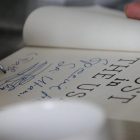Surrealist Writing Rule with Comic Addendum
In my last couple of years at the University of Houston, I twice got the chance to teach an undergraduate creative writing class with Antonya Nelson. The students were all hand-picked and their talents ran over them like… You know those scenes where the horses on a stage coach go crazy? And the guy on the driver’s seat is trying desperately to both hold onto the reins and keep his filthy hat smushed on his head? That’s how a lot of the students’ writing felt. Powerful. Out of control.
One of the students was writing surrealist scenes. Crazy things were happening in the world this student was making and the writing was falling apart.
Nelson then said one of the smartest things I’d ever heard said about writing these kinds of scenes. She asked the student if he had read “The Metamorphosis” by Kafka. The student nodded. “The guy wakes up as a cockroach,” she said. “Everything else stays the same in his world. He turns into a cockroach and it’s a mystery. If his sister comes in and over night she’d been turned into a carousel pony, then everything is different and now it’s not about how this one crazy thing happened but that we reside in a crazy universe where anything can happen and if anything can happen, it’s no longer interesting. All the energy is drained out of the piece.”
Which was of course what was going on in this student’s work. It was a brilliant rule for smart story-telling. And like all brilliant rules of smart story-telling that I come across, I started wielding it like a billy club on everyone around me.
Even on my friend Duncan Trussell, who’s a comedian in Los Angeles, when we were talking about a screenplay he was writing. Trussell listened to me tell him the rule with its Kakfa example. Trussell then said, “Unless of course the sister is a carousel pony, the father’s a helium balloon, and the ceiling is made of monkeys.”
And so this has become in my head the Surrealist Rule with Comic Addendum.
Nearly all of Jim Shepherd’s work follows the Surrealist rule (one weird thing that stands in drastic relief to the mechanisms of the regular world.) Books like Douglas Adams’s The Hitchhiker’s Guide to the Galaxy follow the Comic Addendum (anything can happen at any time. Nuclear missiles turn into a sperm whale and a bowl of petunias.) And every once in a while a book like Nicholson Baker’s House of Holes shows up which seems to follow both the rule and the addendum (things happen in pleomorphic madness, but every crazy thing that happens involves sexuality in one way or another. Women lay silver eggs, a disembodied hand is found in a quarry and turns out to be the perfect lover.)
To this day, I can’t say the Nelson Rule without including the Trussell addendum.



